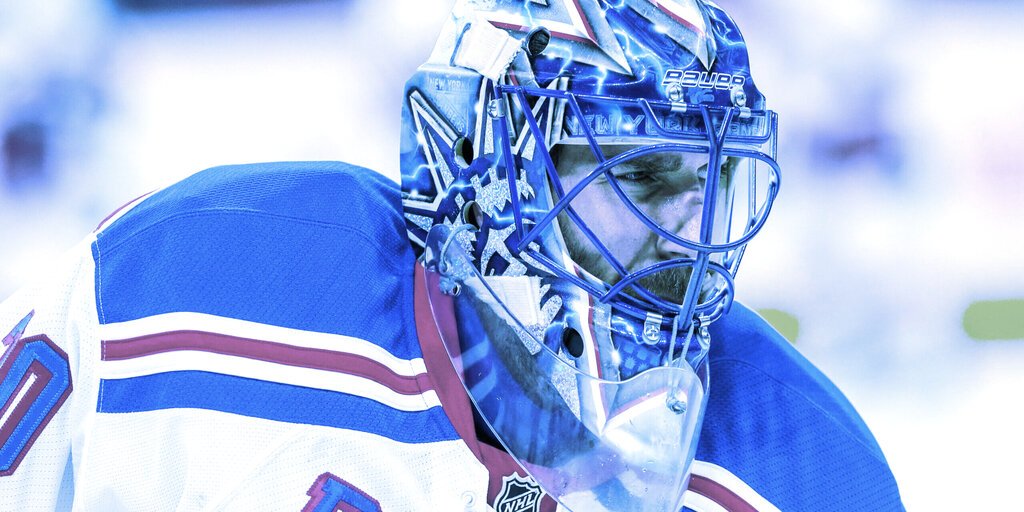Menu
Search
About
By André Beganski
Jun 19, 2022Jun 19, 2022
5 min read
New York Rangers fan David Arends had never bought an NFT, but when he learned his favorite hockey team was releasing a set of digital tokens to commemorate the retirement of legendary goalie Henrik Lundqvist, he thought it could be a unique addition to his collection of jerseys, pucks, and other sports memorabilia.
For $20 apiece, Arends purchased two NFTs: images of tickets to the night dedicated to Lundqvist’s 15-year career with the Rangers, when a banner bearing the player’s name was hoisted to the top of Madison Square Garden as fans cheered. Arends would later print out screenshots of the NFTs and have them framed, hanging them on his wall next to a signed photograph of the goalie.
“I'll never trade it or anything—like it's mine, and I'm going to keep it,” Arends told Decrypt. “To me, it's more of a sentimental thing.”
The world of sports is becoming more saturated with cryptocurrency advertisements, sponsorships, and collaborations every day, and those appear to be pushing more people into the Web3 space.
A recent Seton Hall University survey of 1,500 U.S. adults shows an increasing overlap among sports fans and people who've purchased NFTs or cryptocurrencies such as Bitcoin and Ethereum. The poll found that 57% of households with an avid sports fan have owned digital assets, more than double the rate of households without one, at just 24%.
“Although we are in the early innings of crypto and NFT ownership, sports fans have shown a real proclivity for engagement in these markets,” said Daniel Ladik, a Seton Hall marketing professor and poll methodologist.
Celebrities such as Matt Damon who’ve appeared in commercials promoting cryptocurrency likely have had something to do with that. The Super Bowl is one of the most-watched television events of the year, and this year's game included spots from eToro, Crypto.com, and FTX seen at home by more than 100 million U.S. viewers, according to Nielsen.
Beyond mere TV advertising, major crypto companies have also poured money into sponsorships. Crypto.com paid an estimated $700 million for the naming rights to what had been known as the Staples Center in Los Angeles. The exchange also struck a deal with the UFC in 2021 to become the championship’s first fight kit partner, with Crypto.com’s lions-head logo emblazoned on the chest of fighters' uniforms along with the center of the Octagon. (Since then, the UFC has also clinched a logo deal with VeChain.)
Non-fungible tokens—blockchain-verified proof of ownership of digital or actual items—have created a fresh avenue for companies and sports leagues to connect with fans and turn everything from ticket sales to pictures of sneakers to video clips into collectibles.
The tradition of collecting baseball cards started in the late 19th century when paper cards displaying baseball players along with stats were stuffed into packs of cigarettes as a promotional tool. Now, for many fans, collectibles have simply gone digital.
Seton Hall’s polling found that, overall, people who have traded or owned cryptocurrencies and NFTs mostly were 18 to 34 years old (42% of respondents) compared with people 55 or older (just 7%). The survey also found that men (47%) were more likely than women (14%) to have owned or traded cryptocurrencies or NFTs.
“If managed effectively,” Ladik said, “NFTs could become a major source of revenue as well as a new avenue of fan connection for sports brands. In a digital age, interactive assets like NFTs can drive a sense of holder equity and belonging—key attributes for brand success.”
The NFL, NBA, and UFC all have ventured into the NFT space, working with Dapper Labs to create NFL All Day, NBA Top Shot, and UFC Strike on top of Dapper’s Flow blockchain.
NBA Top Shot was one of the first NFT projects with the blessing of a major sports league, and it recently crossed over $1 billion in total sales volume, according to Cryptoslam.
Projects from Dapper Labs aren’t the only sports-centric collectibles hosted on Flow. The consumer-facing nature of the blockchain was what led NFT Genius founder Jeremy Born to create the Gia marketplace and make it the ecosystem for Ballerz, a collection of pixelated basketball players that primarily serve as PFPs (profile pictures).
“If you create any more friction, which the crypto space has been known for over the last 10 years, it precludes a lot of these people from coming in,” Born told Decrypt, noting some crypto wallets with complicated setup processes may turn off potential users. “It's very intimidating for the average person to come in and try to figure out Metamask.”
Born emphasized that NFTs are boosting crypto adoption not only among sports fans, but also the athletes themselves.
Among those who’ve taken to showing off NFTs on Twitter are icons like Steph Curry and Von Miller. And Tom Brady has his own NFT company called Autograph that's partnered with DraftKings Marketplace.
If the old “flex” was posting photos posing with fancy cars and luxury watches, Born argued the new status symbol for pro athletes could be a Bored Ape. It’s only natural that fans want a PFP flex too.

